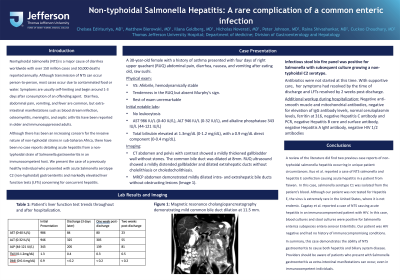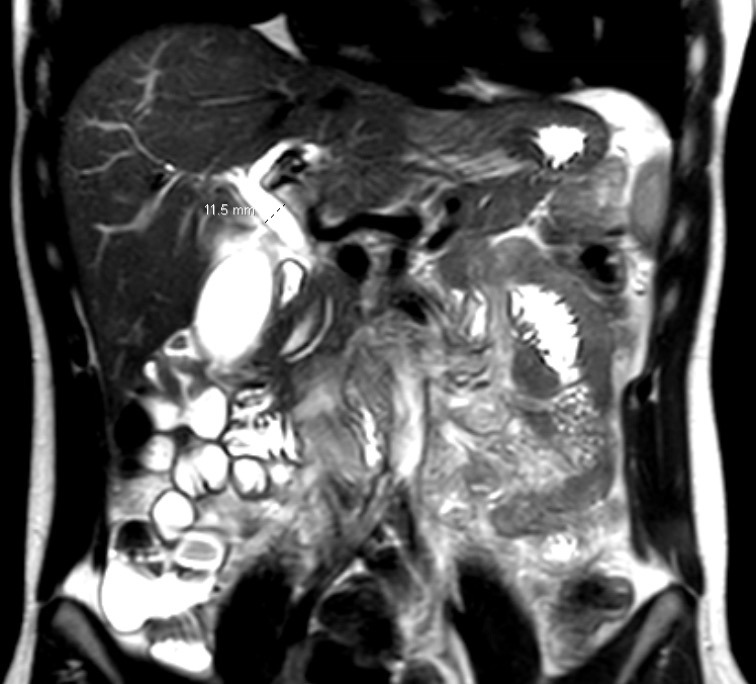Monday Poster Session
Category: Liver
P2532 - Non-Typhoidal Salmonella Hepatitis: A Rare Complication of a Common Enteric Infection
Monday, October 23, 2023
10:30 AM - 4:15 PM PT
Location: Exhibit Hall

Has Audio

Chelsea Edirisuriya, MD
Thomas Jefferson University Hospital
Philadelphia, PA
Presenting Author(s)
Chelsea Edirisuriya, MD, Matthew Bierowski, MD, Ilana P. Goldberg, MD, Nicholas Noverati, MD, Peter Johnson, MD, Raina Shivashankar, MD, FACG, Cuckoo Choudhary, MD
Thomas Jefferson University Hospital, Philadelphia, PA
Introduction:
Hepatitis from Non-typhoidal Salmonella (NTS) gastroenteritis is extremely rare, even more so in immunocompetent patients. Although there has been an increasing concern for the invasive nature of non-typhoidal strains in sub-Saharan Africa, there have been no case reports detailing acute hepatitis from a non-typhoidal strain of Salmonella gastroenteritis in an immunocompetent host. We present the case of a previously healthy individual who presented with acute Salmonella serotype C2 (non- typhoidal) gastroenteritis and markedly elevated liver function tests (LFTs) concerning for concurrent hepatitis.
Case Description/Methods:
A 30-year-old female with a history of asthma presented with four days of right upper quadrant (RUQ) abdominal pain, diarrhea, nausea, and vomiting after eating old, raw sushi. On presentation, she was afebrile and hemodynamically stable. Physical exam demonstrated tenderness in the RUQ but absent Murphy’s sign. Initial labs were notable for: no leukocytosis, AST 986 IU/L (0-40 IU/L), ALT 946 IU/L (0-32 IU/L), and alkaline phosphatase 343 IU/L (44-121 IU/L). Total bilirubin was elevated at 1.3mg/dL (0-1.2 mg/dL), with a 0.9 mg/dL direct component (0-0.4 mg/dL). CT abdomen and pelvis with contrast showed a mildly thickened gallbladder wall without stones. The common bile duct was dilated at 8mm. RUQ ultrasound showed a mildly distended gallbladder and dilated extrahepatic ducts without cholelithiasis or choledocholithiasis. MRCP abdomen demonstrated mildly dilated intra- and extrahepatic bile ducts without obstructing lesions (Image 1). Infectious stool bio fire panel was positive for Salmonella with subsequent culture growing a non-typhoidal C2 serotype. Antibiotics were not started at this time. With supportive care, her symptoms had resolved by the time of discharge and LFTs resolved by 2 weeks post-discharge (Table 1).
Discussion:
In summary, this case demonstrates the ability of NTS gastroenteritis to cause both hepatitis and biliary system disease. Providers should be aware of patients who present with Salmonella gastroenteritis as extra-intestinal manifestations can occur, even in immunocompetent individuals. Standard practice for NTS infection isolated to the intestine is to refrain from antibiotic treatment, as it may lead to both increased drug resistance and prolong the carrier state as well. Although our patient experienced a positive outcome without antibiotics, the exact role of using antibiotics in NTS with liver involvement requires additional investigation.

Disclosures:
Chelsea Edirisuriya, MD, Matthew Bierowski, MD, Ilana P. Goldberg, MD, Nicholas Noverati, MD, Peter Johnson, MD, Raina Shivashankar, MD, FACG, Cuckoo Choudhary, MD. P2532 - Non-Typhoidal Salmonella Hepatitis: A Rare Complication of a Common Enteric Infection, ACG 2023 Annual Scientific Meeting Abstracts. Vancouver, BC, Canada: American College of Gastroenterology.
Thomas Jefferson University Hospital, Philadelphia, PA
Introduction:
Hepatitis from Non-typhoidal Salmonella (NTS) gastroenteritis is extremely rare, even more so in immunocompetent patients. Although there has been an increasing concern for the invasive nature of non-typhoidal strains in sub-Saharan Africa, there have been no case reports detailing acute hepatitis from a non-typhoidal strain of Salmonella gastroenteritis in an immunocompetent host. We present the case of a previously healthy individual who presented with acute Salmonella serotype C2 (non- typhoidal) gastroenteritis and markedly elevated liver function tests (LFTs) concerning for concurrent hepatitis.
Case Description/Methods:
A 30-year-old female with a history of asthma presented with four days of right upper quadrant (RUQ) abdominal pain, diarrhea, nausea, and vomiting after eating old, raw sushi. On presentation, she was afebrile and hemodynamically stable. Physical exam demonstrated tenderness in the RUQ but absent Murphy’s sign. Initial labs were notable for: no leukocytosis, AST 986 IU/L (0-40 IU/L), ALT 946 IU/L (0-32 IU/L), and alkaline phosphatase 343 IU/L (44-121 IU/L). Total bilirubin was elevated at 1.3mg/dL (0-1.2 mg/dL), with a 0.9 mg/dL direct component (0-0.4 mg/dL). CT abdomen and pelvis with contrast showed a mildly thickened gallbladder wall without stones. The common bile duct was dilated at 8mm. RUQ ultrasound showed a mildly distended gallbladder and dilated extrahepatic ducts without cholelithiasis or choledocholithiasis. MRCP abdomen demonstrated mildly dilated intra- and extrahepatic bile ducts without obstructing lesions (Image 1). Infectious stool bio fire panel was positive for Salmonella with subsequent culture growing a non-typhoidal C2 serotype. Antibiotics were not started at this time. With supportive care, her symptoms had resolved by the time of discharge and LFTs resolved by 2 weeks post-discharge (Table 1).
Discussion:
In summary, this case demonstrates the ability of NTS gastroenteritis to cause both hepatitis and biliary system disease. Providers should be aware of patients who present with Salmonella gastroenteritis as extra-intestinal manifestations can occur, even in immunocompetent individuals. Standard practice for NTS infection isolated to the intestine is to refrain from antibiotic treatment, as it may lead to both increased drug resistance and prolong the carrier state as well. Although our patient experienced a positive outcome without antibiotics, the exact role of using antibiotics in NTS with liver involvement requires additional investigation.

Figure: Magnetic resonance cholangiopancreatography demonstrating mild common bile duct dilation.
Disclosures:
Chelsea Edirisuriya indicated no relevant financial relationships.
Matthew Bierowski indicated no relevant financial relationships.
Ilana Goldberg indicated no relevant financial relationships.
Nicholas Noverati indicated no relevant financial relationships.
Peter Johnson indicated no relevant financial relationships.
Raina Shivashankar: Abbvie – Grant/Research Support, Speakers Bureau. Bristol Meyers Squibb – Speakers Bureau. Janssen – Advisory Committee/Board Member, Grant/Research Support.
Cuckoo Choudhary indicated no relevant financial relationships.
Chelsea Edirisuriya, MD, Matthew Bierowski, MD, Ilana P. Goldberg, MD, Nicholas Noverati, MD, Peter Johnson, MD, Raina Shivashankar, MD, FACG, Cuckoo Choudhary, MD. P2532 - Non-Typhoidal Salmonella Hepatitis: A Rare Complication of a Common Enteric Infection, ACG 2023 Annual Scientific Meeting Abstracts. Vancouver, BC, Canada: American College of Gastroenterology.

